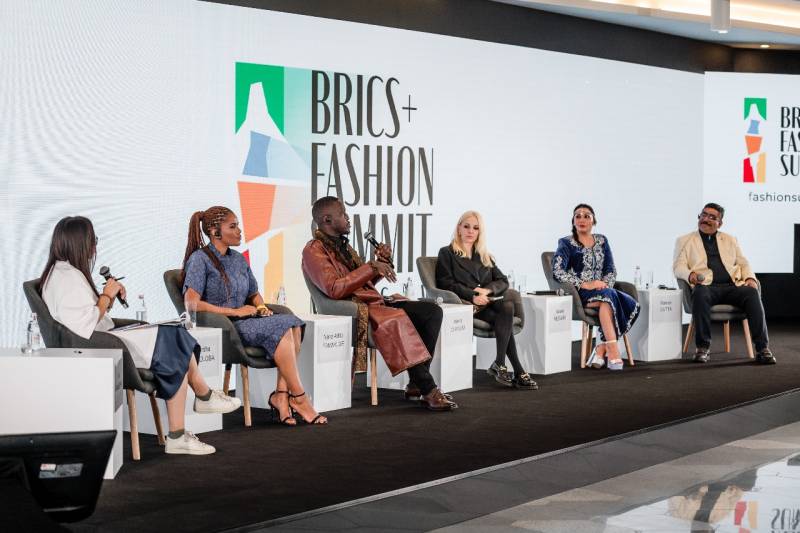
The BRICS+ Fashion Summit, a global platform dedicated to fostering innovation and collaboration in the fashion industry, is a testament to international dialogue's transformative power. Held in Moscow, the summit brought together industry leaders, visionaries, and stakeholders to address critical challenges and opportunities in the ever-evolving fashion landscape. Among the standout discussions were the integration of Artificial Intelligence (AI) into fashion and strategies for navigating global markets — two areas crucial for the industry's future.
The BRICS+ Fashion Summit exemplifies the power of collaboration among nations representing half of the world’s population. Bringing together participants from over 100 countries facilitates the exchange of insights, strengthens professional networks, and inspires innovative approaches to shared challenges. This year’s focus on technology and market expansion reaffirmed its dedication to equipping the fashion industry with the means to achieve sustainable growth.
AI Integration: Transforming Fashion
The integration of AI in fashion is revolutionising every aspect of the industry, from design and production to marketing and customer engagement. At the summit, experts delved into how AI technologies are streamlining operations and opening new creative possibilities.
Julia Elina, an AI artist, showcased the potential of AI with her creation of “Anna,” a neuro-avatar capable of modeling, blogging, and even hosting virtual events. This innovation eliminates the need for traditional resources like photography studios and makeup artists, demonstrating the cost and time efficiencies AI can bring. Such technologies empower designers to focus on strategic and creative tasks while enhancing operational efficiency.
AI also plays a pivotal role in enhancing user experiences. Virtual fitting rooms, for instance, allow consumers to “try on” clothes digitally, reducing returns and improving satisfaction. As Konstantin Sobolev, Head of the ‘Video Generative AI’ research group, noted, AI is increasingly embedded in creative and operational processes, enabling brands to analyse trends and consumer behavior with unprecedented precision.
The BRICS+ Fashion Summit’s efforts to spotlight AI and global market strategies reflect its broader mission to empower the fashion industry with tools and knowledge for sustainable growth
Despite these advancements, the summit emphasised a balanced approach to AI adoption. Audrey Taillée, Director of Fashion and Brand Relations, argued that while AI can optimise workflows, it cannot replicate the human touch essential to artistry and storytelling in fashion. This perspective highlights the need to use AI as a tool to complement, rather than replace, human creativity.
Navigating Global Markets: A Blueprint for Success
The global fashion market presents immense opportunities, but navigating its complexities requires strategic planning and a deep understanding of local and international dynamics. The summit’s discussions on this theme shed light on the pathways to global success.
Local brands from BRICS+ countries were encouraged to embrace storytelling as a means of differentiation. Alexey Bazhenov, founder of the Institute of Development in the Fashion Industry Beinopen, emphasised that a brand’s identity is a hybrid of material and informational elements. Effective storytelling not only makes brands memorable but also bridges cultural gaps, fostering connections with diverse audiences.
Maintaining high-quality standards and embracing innovation are essential for competing on the global stage. Participants discussed the importance of leveraging digital tools for promotion, utilising data analytics, and collaborating with marketplaces to gather insights and adapt strategies. In an era where consumer preferences are increasingly data-driven, such measures can provide brands with a competitive edge.
Mmantlha Sankoloba, CEO of the Botswana Exporters and Manufacturers Association, highlighted the importance of cultural localisation in export strategies. By understanding and respecting the traditions and practices of target markets, brands can create authentic products that resonate with consumers worldwide. This approach not only drives sales but also strengthens cultural ties, a core value of the BRICS+ initiative.
A Vision for the Future
The BRICS+ Fashion Summit’s efforts to spotlight AI and global market strategies reflect its broader mission to empower the fashion industry with tools and knowledge for sustainable growth. By fostering innovation, promoting collaboration, and addressing shared challenges, the summit is shaping a future where fashion transcends borders to become a unifying global force.
As the industry continues to evolve, the lessons from the summit serve as a guiding light for brands and stakeholders. Whether through the responsible integration of AI or the strategic navigation of global markets, the fashion world is poised to embrace a future defined by creativity, innovation, and inclusivity.

